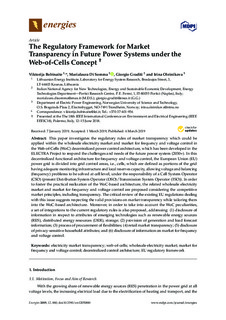| dc.description.abstract | This paper investigates the regulatory rules of market transparency which could be applied within the wholesale electricity market and market for frequency and voltage control in the Web-of-Cells (WoC) decentralized power control architecture, which has been developed in the ELECTRA Project to respond the challenges and needs of the future power system (2030+). In this decentralized functional architecture for frequency and voltage control, the European Union (EU) power grid is divided into grid control areas, i.e., cells, which are defined as portions of the grid having adequate monitoring infrastructure and local reserves capacity, allowing voltage and balancing (frequency) problems to be solved at cell level, under the responsibility of a Cell System Operator (CSO) (present Distribution System Operator (DSO)/Transmission System Operator (TSO)). In order to foster the practical realization of the WoC-based architecture, the related wholesale electricity market and market for frequency and voltage control are proposed considering the competitive market principles, including transparency. The critical review of the existing EU regulations dealing with this issue suggests respecting the valid provisions on market transparency while tailoring them into the WoC-based architecture. Moreover, in order to take into account the WoC peculiarities, a set of integrations to the current regulatory rules is also proposed, addressing: (1) disclosure of information in respect to attributes of emerging technologies such as renewable energy sources (RES), distributed energy resources (DER), storage; (2) provision of generation and load forecast information; (3) process of procurement of flexibilities; (4) retail market transparency; (5) disclosure of privacy-sensitive household attributes; and (6) disclosure of information on market for frequency and voltage control. | nb_NO |

